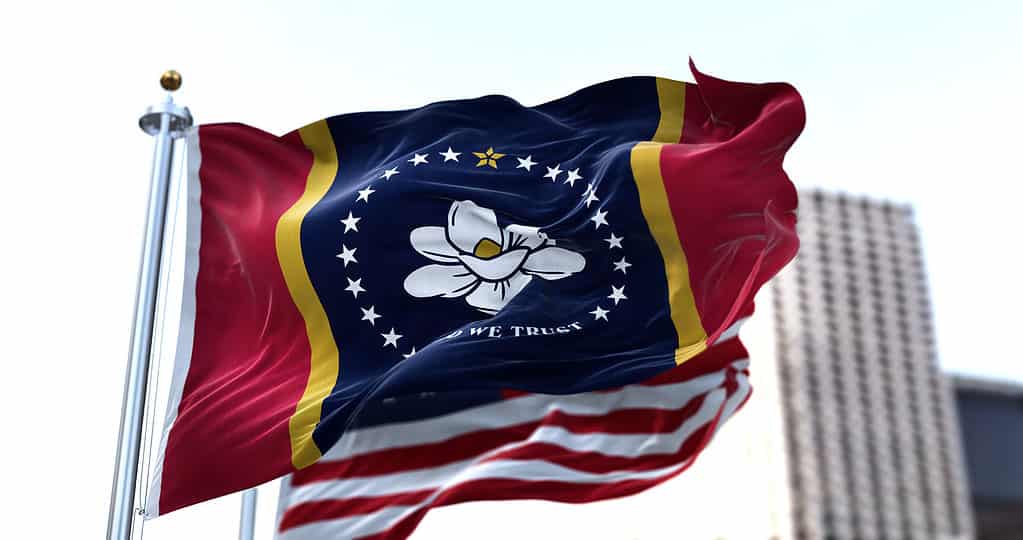Mississippi is a constituent state of the United States of America located in the southeastern region of the country. The state shares its borders with Alabama in the east and the Gulf of Mexico in the south. It also shares borders with Tennessee in the north, Louisiana in the southwest, and Arkansas in the northwest. The state gets its name from the Mississippi River, which flows through its western boundary. The term “Mississippi” comes from a Native American word, misi-ziibi, which means “great waters/river, or father of waters.” The state’s capital city is Jackson, which is also recognized as the state’s largest and most occupied city.
Mississippi is a relatively small state, and it ranks low on the list of properly developed states in the United States. Nevertheless, it is still home to about three million people, and as such, it has a means of identification, its flag, which we’ll be looking at in this article. You will learn about the history, meaning, and symbolism of Mississippi’s flag here.
When Was Mississippi as a State Founded?

©iStock.com/SeanPavonePhoto
The history of the area that is now Mississippi dates back as far as 10,000 BC. This area was primarily occupied by at least three separate groups of Native Americans, the largest of which was the Choctaw. The first primary European exploration of the region happened in 1540 and was led by Spanish explorer Hernando de Soto. He oversaw a sizable expedition into the area, and they spent the winter on the Pontotoc Ridge. However, he and the rest of the people with him focused their efforts elsewhere once they arrived at the Mississippi River the following spring and failed to find any gold or silver in the area.
Over a century later, a different group of people returned to the region. This time, it was a small group of French Canadians that had sailed down the Mississippi River. These people immediately noticed the commercial potential of the area. By 1699, a French expedition under the command of Pierre le Moyne d’Iberville had established France’s claim to the lower Mississippi valley, and various French settlements were founded throughout the area. This occupation of the French lasted a while, until after the French and Indian war, which resulted in the French ceding its regions that were east of the Mississippi River to Great Britain. This surrender was made under the terms of the Treaty of Paris and gave the British control over the former French territories.
This era witnessed the introduction of enslaved Africans into the area, but a class of “free people of color” was established. This class only provided for the predominantly multiracial offspring of European males and enslaved or free black women, as well as their mixed-race offspring, and did not include all enslaved Africans. The Mississippi Territory was established on April 7, 1798, following the cession of this region to the fledgling United States of America by Britain. The reason for this surrender was the American Revolution, which took place between 1775 and 1783. Mississippi eventually became the 20th state of the United States on December 10, 1817, with David Holmes as the first governor.
Geography of Mississippi
Mississippi is entirely made up of lowlands. However, Woodall Mountain, in the northeastern part of the state, rises to a height of 807 feet (246 meters) above sea level and is the state’s highest point. Except for its steep northeast corner, Mississippi is seated within the eastern gulf portion of the larger physiographic region known as the coastal plain. Mississippi is also extremely forested, with either wild or domesticated trees covering more than half of the state’s surface. Also, large areas of cottonwood, willow, and oak trees can be found on the Mississippi Alluvial Plain. This area is also often known as the Delta and consists primarily of cropland and aquaculture ponds.
The Gulf of Mexico is bordered by the coastal region, often known as the Coastal Meadows or Terrace. Unlike the state’s other areas, the sandy soil in this area makes it hard to grow vegetation. The state of Mississippi is also home to several rivers, like the Big Black River, the Pascagoula River, and the Yazoo River. Also, major lakes in the state include Sardis and Grenada.
Climate of Mississippi
With lengthy, hot, and humid summers, and short, mild winters, Mississippi has a humid subtropical climate. Mississippi benefits from a climate that is good for agriculture because of its position. Despite the usual peaceful weather, the end of summer and the beginning of fall is a period that is well-known for hurricanes in the state. Between June and October, the coastal areas are susceptible to cyclones blowing inland from the Gulf of Mexico. On the other hand, the state’s northern and southern regions are more prone to tornadoes; the northern region at the start of the year and the southern region near the end.
Culture and Cuisine of Mississippi
With a population of almost three million people, Mississippi is a relatively small state compared to many of the other states in the United States of America. The state covers an area of 125,460 square kilometers (48,441 square mi). As mentioned earlier, the most populated city in the state is Jackson, and because Mississippi is home to people from different cultures and backgrounds, the state’s overall culture is a blend of all these different cultures. About three-fifths of Mississippi’s population is made up of people of white European heritage, mostly of Irish, British, or northern European descent, with African Americans taking up a large chunk of the remaining population.
Before 1940, these African Americans were the majority due to the importation of slaves, but their numbers reduced after many of them got their freedom and started to leave the state. There are also people from different cultures that make up the rest of the population, including Asians, Native Americans, and Hispanics. The colonists that governed Mississippi before it officially became a region of the growing United States of America were mostly Roman Catholics. Because of this early exposure, Christianity is the primary religion practiced in the state, giving Mississippi the title of the “most religious state in the United States.”
Apart from cultural diversity, the cuisine of Mississippi is also one of the benefits the area enjoys from being ruled by different groups of people and countries. Despite the influence of these other cultures, the inhabitants of Mississippi have also been able to make dishes based entirely on their creativity, using different methods and ingredients. Some of the state’s most popular foods include biscuits and gravy, the Mississippi Mud Pie, and seafood.
History of the Flag of Mississippi

©iStock.com/rarrarorro
Before 1861, Mississippi had no flag. The first flag adopted by the state came into use when the state withdrew from the Union before the American Civil War. This flag was called the “Bonnie Blue” flag, which was a blue field with a five-pointed white star at the center, and it was hung over the state building in Jackson to signify the state’s independence. The Magnolia flag replaced the Bonnie Blue flag and had a magnolia tree in the middle, a blue field with a white star in the upper left-hand corner, and a red border around the edge of the flag. During the period of March 30, 1861, to August 22, 1865, it served as the state’s official flag.
The flag that took the place of the Magnolia flag included three equal horizontal triband of blue, white, and red, together with the canton of the Army of Northern Virginia battle banner. The flag also had 13 stars that signified the 13 founding states of the Union. This flag was used from February 7, 1894, until 2021, when the current flag was adopted.
Flag of Mississippi: Meaning and Symbolism

©iStock.com/Andrey Semenov
The words “In God We Trust” are written underneath a white magnolia flower surrounded by 21 stars on the current flag of Mississippi, which was adopted on January 11, 2021. This is all placed atop a blue Canadian pale that has two vertical gold borders on a red field. The top star is made up of a pattern of five diamonds, which is an Indigenous emblem while the other 20 stars are white.
The new state flag’s magnolia bloom represents hospitality and hope, surrounded by 20 stars, denoting Mississippi’s status as the 20th state in the nation, and a gold five-point star to represent the state’s native Native American tribes. The blue color, which is used to symbolize vigilance, justice, and endurance, also represents the American flag. The two outer stripes, which are red, represent tenacity and bravery. Finally, a tribute to Mississippi’s rich cultural heritage is represented via the use of two thin strips of gold.
Up Next:
The 10 Countries With Stars On Their Flags, and Their Meaning
Red Flag With Green Star: Morocco Flag History, Meaning, and Symbolism
17 Countries That Have Bicolor Flags
The post The Flag of Mississippi: History, Meaning, and Symbolism appeared first on AZ Animals.
from Animal News, Facts, Rankings, and More! - AZ Animals https://ift.tt/LI2pRxw